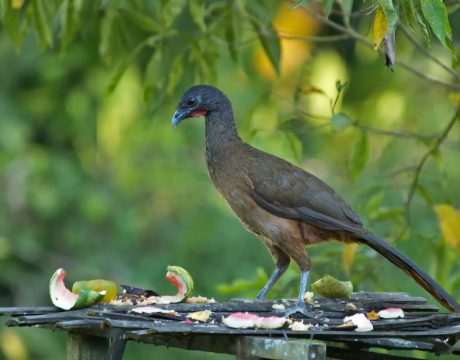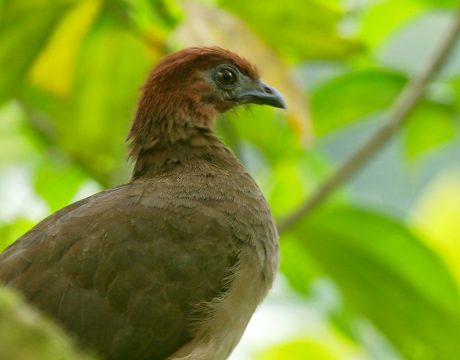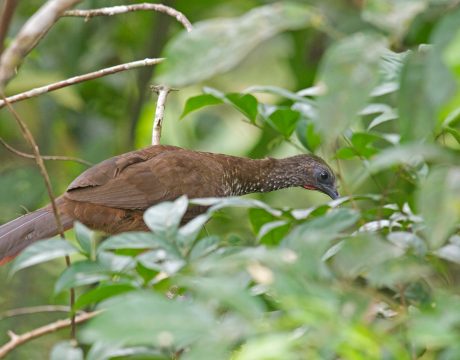Return of Bird of the Week: Crimson-mantled Woodpecker
This will be the last Return of Bird of the Week here at the Mudflats. Differences in some of the underlying parts of WordPress have made cross-posting difficult. The Satuday series will continue over at Wickersham’s Conscience if you haven’t had enough birds yet. Thanks for reading the 350 +/- posts. Get out and enjoy the birds. Another very handsome, very colorful woodpecker, the Crimson-mantled is found along the eastern and westerly slopes of the Andes from Columbia to central Bolivia. It’s a medium-sized woodpecker, about the size of the Hairy Woodpecker, and fairly common across its range. There are…
Return of Bird of the Week: Red-stained Woodpecker
WC will start 2021’s Bird of the Week with a spectacular bird: the Red-stained Woodpecker. The male, in particular, is beautiful bird, with a golden-brown back, a heavily barred chest, a red head and the signature red-staining on primary and secondary feathers in the wings. The female lacks the red staining and red head, and is amazingly cryptic and hard to find. This is a bird of the middle and upper zones of mature trees in the Amazonian basin. It’s uncommon in lower parts of the jungle forest. The first two photos were taken from a tower 120 feet up…
Return of Bird of the Week: Downy Woodpecker
Common, very widely distributed and tolerant of humankind, the Downy Woodpecker is easily attracted to a suet feeder. Its range extends across North America, from the Seward Peninsula in Alaska to southern Florida, and from southern California to Labrador. A smaller version of the Hairy Woodpecker, it’s interesting because the male and female generally forage on different parts of a tree or shrub. The male usually probe smaller branches; the female on larger branches and the trunk. There are seven subspecies. The female above is medianus, found across the boreal forest; the male is leucurus, fond in the Rocy Mountains…
Return of Bird of the Week: Hairy Woodpecker
The Hairy Woodpecker is one of the most widely distributed and most highly variable bird species in North America. Found from the south slopes of the Brooks Range in northern Alaska to the mountains of Panama, it’s familiar to anyone who has hung up a suet feeder. But in the woods, it’s fairly rare to see a Hairy Woodpecker. For a big bird, that drums frequently, it can be hard to find. They aren’t “hairy,” of course. The name comes from the long, thread-like feathers in the whitish areas on their backs. Those feathers are difficult to see in the…
Return of Bird of the Week: Black-backed Woodpecker
Ornithologists called the Black-backed Woodpecker “enigmatic” and the term is apt. It’s a bit of a specialist, inhabiting by preference damaged forests. Historically, in Alaska it was found reliably in recent forest fire burns, but with the increased numbers and extent of wildfires, it seems to be more dispersed now. It also prefers forests invaded by various tree-eating/wood-boring beetles, yet has not extended its Alaska range into southern Alaska in response to the massive invasion of bark beetles there. This is primarily a boreal forest species, ranging across the forests of central Alaska and Canada, but is also found in…
Return of Bird of the Week: Pileated Woodpecker
We have exhausted WC’s even marginally decent photos of Cracids – the Chachalacas, Curassows and Guans. So we’ll shift to woodpeckers, the Piciformes, and start with North America’s largest surviving woodpecker, the Pileated. In the late 1990s, WC was flyfishing for steelhead trout along the Situk River, in southeastern Alaska, near Yakutat. One early foggy spring morning, WC and a buddy set out across the water meadows east of the river, aiming upstream to get away from the crowd. From a stand of deciduous trees not far from the Forest Service road, WC heard a sound like a hatchet striking…
Return of Bird of the Week: Rufous-vented Chachalaca
Last week we looked at the Rufous-headed Chachalaca. This week we go to the other end of the bird for the critical field mark. Mrs. WC thinks it’s unseemly to name a bird after its naughty bits, but there it is. These photos are more than fourteen years old, taken with an Olympus E-1, Olympus’s first Four-Thirds Digital Single Lens Reflex camera. It was state of the art at the itme, but the lamest, cheapest smart phone camera takes much better photos today. These photos, taken at f5 (wide open), 1/200 and ISO800 with a 50-200mm zoom and a 1.4…
Return of Bird of the Week: Rufous-headed Chachalaca
In WC’s experience, at least, this is the flightiest, the most easily spooked of the Cracids that WC has seen. You can see some motion blur in the head in this photo; even at ISO1600, the fastest WC’s Olympus E-3 could shoot without very serious grain, the shutter speed was only 1/200th of a second at f7.1. The bird’s head came up, it turned away and ran down the branch, disappearing in a tangle of liana vines. There were five birds in the tree; this is the best photo. Sigh. You woudn’t know it from this photo, but this is…
Return of Bird of the Week: Speckled Chachalaca
Another “cha-cha” bird, this time a smaller member of the Chachalacas, the Speckled Chachalaca. Like a lot of the Cracids, it has consistently denied WC a clear photo opportunity. This species has a fairly wide distribution, from Columbia to Bolivia, along the eastern slopes of the Andes. It’s an easy bird to identify, with the characteristic speckles along the throat, expanding to scalloping on the chest. It has a strong, curved bill and a small dewlap in comparison to its cogeneors. It forages in groups of as many as six birds (possibly families?), eating fruits, flower buds and leaves. The…
Return of Bird of the Week: Chaco Chachalaca
Chaco Chachalaca, Panatnal, Brazil One of WC’s birding buddies call this genus of Cracids the “Cha-cha” birds. Chachalacas are cousins to the Currasows and Guans featured earlier. They generally tend to be a bit drabber than those cousins, but there are exceptions. Chaco Chachalacas are famous for their dawn chorus; this bird was vocalizing when WC got this shot. The male’s morning call is described as a “bink, ka chee chaw raw taw, chaw raw taw, chaw raw taw” and is very loud, audible for half a mile. You be the judge:














